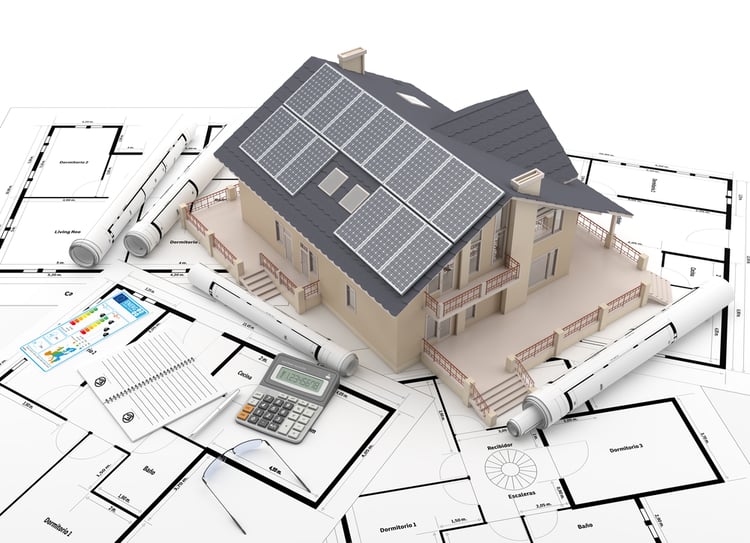If you compare solar panel prices online, you'll notice that their costs per watt are much lower than what installers quote. This can lead to the misconception that solar companies are making very high profits, but the truth is different. A solar energy system has multiple components, and photovoltaic modules are just one of them.
The National Renewable Energy Laboratory (NREL) publishes the annual U.S. Solar PV and Energy Storage System Cost Benchmark and the latest edition was made available in November 2021. NREL provides a detailed analysis of solar PV system costs by market segment: residential, commercial and public services.
Get a professional solar photovoltaic system design for your building and reduce your energy bills.
When comparing solar energy projects, economies of scale are evident. As the size of solar projects increases, their cost per watt decreases significantly. This is reflected in the average prices in NREL's most recent technical report:
|
Size of solar photovoltaic system |
Typical cost |
|
7.15 kW Residential |
$2.65/watt |
|
200 kW rooftop commercial |
$1.56/watt |
|
500 kW Ground Mounted Commercial |
$1.64/watt |
|
100 MW Fixed Tilt Utility |
$0.83/watt |
|
100MW Single Axis Tracking Utility |
$0.89/watt |
Notice how the cost per watt is almost 70% lower in large photovoltaic systems compared to small residential systems. However, solar panels are financially viable at all project scales. Residential and commercial solar systems are analyzed based on electricity savings at retail prices, while large-scale projects are analyzed based on electricity production at wholesale prices. In other words, smaller systems have a higher cost per watt, but their economic benefit per kWh generated is also higher.
Prices for solar photovoltaic systems: what do they include?

Photovoltaic panels are the most visible part of a solar energy system, but there are many other components at work. These include solar inverters , racking systems, wiring, circuit breakers and monitoring systems. Depending on how your solar power system is designed, it may include optional components like batteries and power optimizers.
The quoted price of a solar energy system also includes indirect costs that are not evident when looking at a completed installation: licensing, inspections, grid interconnection, taxes, transportation, land acquisition, design work, skilled labor, customer acquisition, overhead, profit margins, etc. To get a clear and general idea of how much solar panels cost, including the above costs, which vary by state in the US, it is advisable to contact a professional solar installation company.
Solar panels represent only a fraction of the system costs and this was analyzed by NREL. The November 2021 technical report considers a photovoltaic module cost of US$0.34 per watt, which is equivalent to:
- 12.8% of costs in a typical residential installation
- 21.8% on a commercial rooftop system
- 41.0% on a large system without solar tracking
As the size of a solar panel increases, photovoltaic modules represent a higher percentage of total costs, while the percentage of indirect costs decreases. This is also why large projects are more sensitive to solar module prices and more dependent on low-cost imports from abroad .
Individual cost of solar photovoltaic system components
The NREL report also breaks down solar photovoltaic system costs by item and by market segment. The following table summarizes the November 2021 report findings:
|
Solar Components and Soft Costs |
Residential market price contribution |
Commercial market price contribution |
Market price contribution on utility scale |
|
Photovoltaic module |
$0.34/W |
$0.34/W |
$0.34/W |
|
Inverter |
US$0.15/W single-phase string type $0.28/W String + Power Optimizers $0.31/W Microinverter |
US$0.08/W three-phase string type $0.16/W String + Power Optimizers $0.31/W Microinverter |
$0.05/W |
|
Structural BOS (racks) |
$0.09/W |
$0.11/W – $0.18/W |
$0.09/W – $0.12/W |
|
Electric BOS |
$0.19/W – $0.30/W |
$0.13/W – $0.45/W |
$0.07/W – $0.14/W |
|
Sales tax |
5.1% national average |
5.1% national average |
5.1% national average |
|
Personally Identifiable Information* |
$0.21/W small installer National integrator from US$ 0.23/W |
$0.03/W – $0.12/W |
$0.02/W – $0.06/W |
|
Sales and Marketing |
$0.42/W small installer $0.58/W national integrator |
N/A |
N/A |
|
The overload |
$0.27/W small installer US$0.28/W national integrator |
$0.27/W – $0.47/W developer overhead 13% of equipment EPC overhead |
2-12% developer overhead 8.67-13% materials and equipment, 23-69% EPC labor overhead |
|
Typical profit |
17% |
7% |
5%-8% |
*NOTE: PII stands for licensing, inspection and interconnection.
As you can see from the table above, the price of a solar energy system is the sum of many individual costs. The table considers costs that tend to be within a certain price range, but others are more variable – supply chain costs and skilled labor are two examples.

